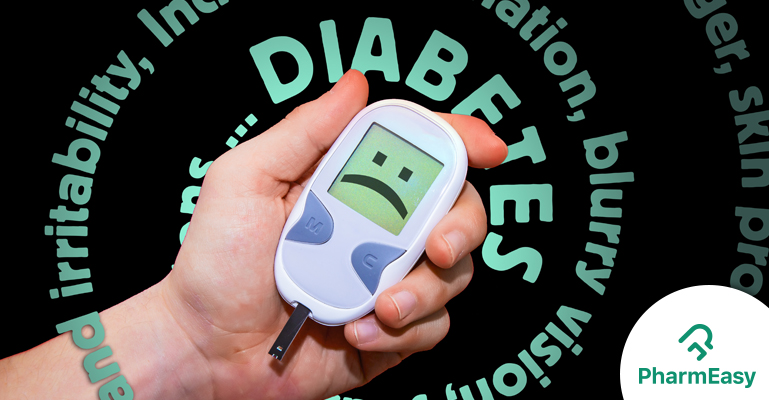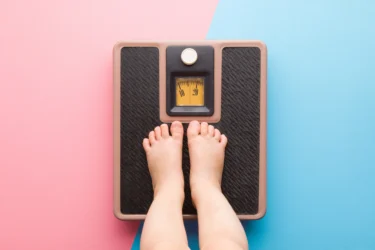11 Signs of Type 1 Diabetes in Children You Must Not Ignore
By Dr. Amruta Prabhu +2 more

Get,

to manage your symptom
Get your,


4 Cr+ families
benefitted

OTP sent to 9988776655



You’ve successfully subscribed to receive
doctor-approved tips on
Whatsapp

Get ready to feel your best.

Hi There,
Download the PharmEasy App now!!


Register to Avail the Offer
Send OTPBy continuing, you agree with our Privacy Policy and Terms and Conditions

Hi There,
Sign up on PharmEasy now!!
Trusted by 4 crore+ families

OTP sent to 9988776655



You have unlocked 25% off on medicines




Code: NU25
By Dr. Amruta Prabhu +2 more
Table of Contents
Diabetes is a condition where the body becomes resistant to insulin or does not produce it to metabolize sugar in the blood. Insulin is a hormone produced by the pancreas in our body, which acts by delivering glucose molecules to the cells for the release of energy1.
Type 1 and type 2 are the two major types of diabetes. In type 1 diabetes, the body does not produce insulin at all. In type 2 diabetes, the body becomes resistant to insulin or creates it in insufficient quantities.

Type 1 diabetes is also known as Juvenile Diabetes. It affects children and adolescents more often but can develop in adults even in rare circumstances
The exact reason why type 1 diabetes occurs is still a topic of debate2. Research has proved that genetic expression, inflammation levels, and in some cases, even viral infections have a considerable role to play in this type of diabetes2.
It is believed that the body’s immune system turns against itself and destroys islets of Langerhans, the pancreatic cells which produce insulin2,3. When there is no insulin in the blood, the level of glucose increases leading to severe complications if left untreated2.
Children are more prone to develop complications of type 1 diabetes like hypoglycemia or hypoglycemia or diabetic ketoacidosis, and there are high chances that the symptoms for these complications are frequently missed and underdiagnosed. Timely intervention is thus crucial.
Dr. Ashish Bajaj, M.B.B.S., M.D. in Clinical Pharmacology and Toxicology
Type 1 diabetes may have the potential to damage major organs or even organ systems in the body. Keeping the blood sugar levels under control is the key to reducing the risks associated with Type 1 Diabetes in children1. Below are some risk factors which may come along with Type 1 Diabetes:
Most of children with type 1 diabetes only get diagnosed when they present with Diabetic ketoacidosis, which is state in type 1 diabetes with very high sugar, vomiting, abdominal pain, and fruity smelled fast breathing1.
Dr. M.G. Kartheeka, MBBS, MD(Pediatrics)

One of the prominent warning signs of type 1 diabetes is increased urination1. High sugar levels lead to a toxic environment in the blood. The body tries to bring back balance by eliminating the excess sugar. The kidneys produce excessive urine, and this makes one take frequent trips to the washroom9.

The body can get dehydrated due to frequent urination. To replenish the fluids, it demands more water by making the child feel thirsty. If your child is demanding water too frequently, talk to his doctor. It could be a warning sign of type 1 diabetes1.

The body converts the food we eat into glucose, the smallest currency of energy. When one suffers from type 1 diabetes, glucose cannot be used by the body as there is a lack of insulin- the hormone responsible for delivering glucose molecules to the cells1. This makes one feel low in energy. So, the body demands more food to stave off hunger. It is a vicious cycle. If your child has an increased appetite, observe if he is showing other warning signs of type 1 diabetes.

The continually fluctuating blood sugar levels create havoc on the mood of a person. Children are no different. When the sugar levels are low, we feel morose and irritable. When they are high, we feel full of energy and are in a better mood. When the levels dip too low or go too high, it could make one feeling depressed or manic10. Frequent and unexplained mood swings in kids could be a warning sign of type 1 diabetes.

High sugar levels affect the fluid levels in eye lens temporarily causing blurry vision. When the blood sugar levels come under control and the diabetes is managed, the vision returns to normal1. Vision changes are an early warning sign of type 1 diabetes.

In type 1 diabetes, there may be a high amount of sugar in the blood but since it cannot be used by the cells, this makes the person feel weak and tired. Excessive and unexplained fatigue and weakness is a visible warning sign of type 1 diabetes1.

While the body may demand more food and feel more hungry than usual, since the primary energy-providing mechanism is not working correctly, the patient may experience unexplained weight loss1. The high sugar levels are not helping the cells, which are deprived of energy leading to a decline in body mass due to loss of fat and muscle in the body12.

This is commonly observed in children who have not been wetting the bed earlier. High sugar levels lead to frequent urination. Children cannot control their urge in the sleep leading to bedwetting, another warning sign of type 1 diabetes1.

When the body uses fat to produce energy, it leads to the formation of ketones. Ketones provide a fruity-smelling scent to the breath. If left unchecked, high levels of ketones in the body lead to ketoacidosis, which is a life-threatening condition1,2.

This is another warning sign of type 1 diabetes. High sugar levels can lead to an unhindered proliferation of yeast, bacteria, and fungi12. Especially girls become prone to many vaginal and urinary tract infections. Controlling the blood sugar is the best way to reduce the frequency of these infections.

When the body burns fats and muscles instead of carbohydrates to release energy, it releases ketones- the waste materials of the process. In small amounts, they do not cause much damage, but in high quantities, they can cause toxicity in the blood leading to nausea and vomiting2,12.
Also Read: Home Remedies for Cold in Infants and Babies
In type 1 diabetes, the symptoms appear quickly, and the onset of the disease is sudden. Since most of the patients who have type 1 diabetes are children, they might not understand the signs of the disease. As parents or guardians, it is crucial to arm oneself with knowledge of the symptoms of diabetes in children. Knowing the early signs can help you detect the condition early on and take measures to achieve sugar control, thereby avoiding long-term complications of diabetes, some of which can be fatal. With consistent care and appropriate medication, the situation can be brought under control.
Disclaimer: The information provided here is for educational/awareness purposes only and is not intended to be a substitute for medical treatment by a healthcare professional and should not be relied upon to diagnose or treat any medical condition. The reader should consult a registered medical practitioner to determine the appropriateness of the information and before consuming any medication. PharmEasy does not provide any guarantee or warranty (express or implied) regarding the accuracy, adequacy, completeness, legality, reliability or usefulness of the information; and disclaims any liability arising thereof.
Links and product recommendations in the information provided here are advertisements of third-party products available on the website. PharmEasy does not make any representation on the accuracy or suitability of such products/services. Advertisements do not influence the editorial decisions or content. The information in this blog is subject to change without notice. The authors and administrators reserve the right to modify, add, or remove content without notification. It is your responsibility to review this disclaimer regularly for any changes.
Comments

Leave your comment...
You may also like
Comments